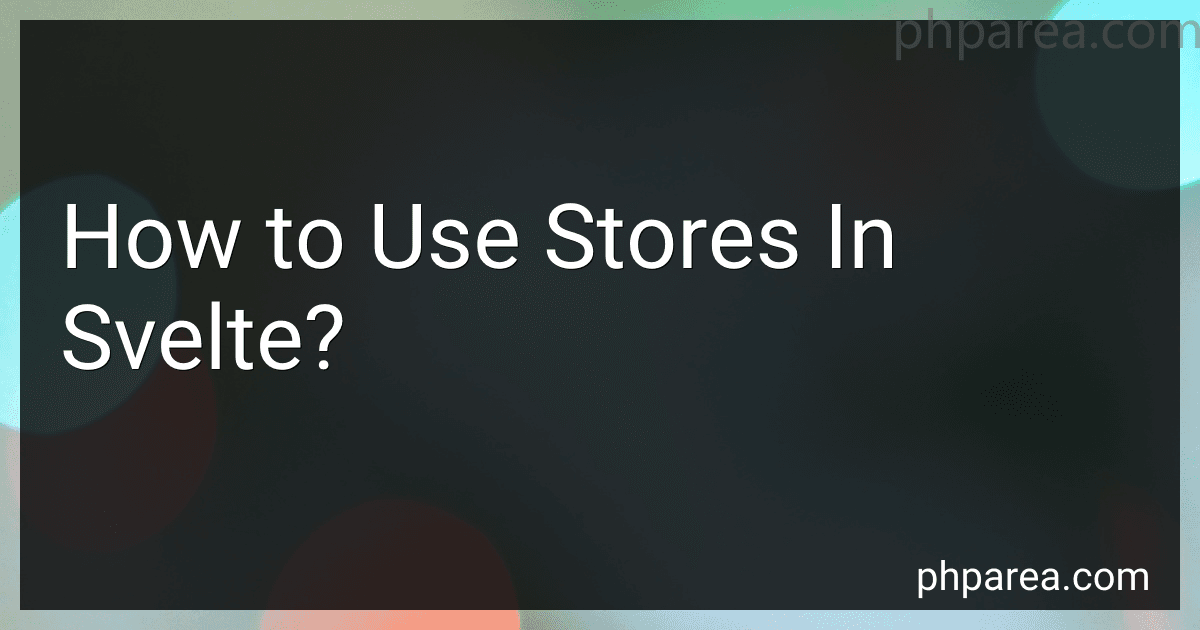Posts (page 61)
-
 4 min readHandling form submissions in Svelte involves creating a form component that captures user input and sends it to a server or performs some other action. You can use the submit event of the form element to trigger a function in your Svelte component, where you can access the form data and process it as needed. To prevent the default form submission behavior, you can call event.preventDefault() at the beginning of your submit handler function.
4 min readHandling form submissions in Svelte involves creating a form component that captures user input and sends it to a server or performs some other action. You can use the submit event of the form element to trigger a function in your Svelte component, where you can access the form data and process it as needed. To prevent the default form submission behavior, you can call event.preventDefault() at the beginning of your submit handler function.
-
 4 min readIn order to set up SEO-friendly URLs in Drupal, you can first enable the Path module in your Drupal installation. This module allows you to create custom URLs for your content, which can improve your website's search engine optimization. Once the Path module is enabled, you can manually create custom URLs for each piece of content on your site, or you can use the Pathauto module to automatically generate SEO-friendly URLs based on the title of your content.
4 min readIn order to set up SEO-friendly URLs in Drupal, you can first enable the Path module in your Drupal installation. This module allows you to create custom URLs for your content, which can improve your website's search engine optimization. Once the Path module is enabled, you can manually create custom URLs for each piece of content on your site, or you can use the Pathauto module to automatically generate SEO-friendly URLs based on the title of your content.
-
 5 min readLifecycle methods in React are special methods that get called automatically at different stages of a component's lifecycle. These methods allow you to perform actions or operations at specific points during the component's existence.There are three main categories of lifecycle methods: mounting, updating, and unmounting. Mounting methods are called when a component is first rendered to the DOM. Updating methods are called when a component's props or state change.
5 min readLifecycle methods in React are special methods that get called automatically at different stages of a component's lifecycle. These methods allow you to perform actions or operations at specific points during the component's existence.There are three main categories of lifecycle methods: mounting, updating, and unmounting. Mounting methods are called when a component is first rendered to the DOM. Updating methods are called when a component's props or state change.
-
 8 min readCaching in Drupal helps to improve the performance and speed of the website by storing certain data and content temporarily. To set up caching in Drupal, you can go to the Performance page in the admin dashboard. From there, you can enable caching options like caching pages for anonymous users, caching blocks, and enabling CSS and JavaScript file aggregation. Additionally, you can also install caching modules like Varnish or Memcached to further optimize the caching process.
8 min readCaching in Drupal helps to improve the performance and speed of the website by storing certain data and content temporarily. To set up caching in Drupal, you can go to the Performance page in the admin dashboard. From there, you can enable caching options like caching pages for anonymous users, caching blocks, and enabling CSS and JavaScript file aggregation. Additionally, you can also install caching modules like Varnish or Memcached to further optimize the caching process.
-
 5 min readIn React, handling asynchronous operations involves using functions like fetch(), axios(), or native JavaScript promises. One common approach is to use the useEffect() hook to trigger the async operation and store the resulting data in a state variable.You can also use the async/await syntax within your async functions to make asynchronous code appear synchronous and easier to read. This helps ensure that your code runs in the proper order and avoids callback hell.
5 min readIn React, handling asynchronous operations involves using functions like fetch(), axios(), or native JavaScript promises. One common approach is to use the useEffect() hook to trigger the async operation and store the resulting data in a state variable.You can also use the async/await syntax within your async functions to make asynchronous code appear synchronous and easier to read. This helps ensure that your code runs in the proper order and avoids callback hell.
-
 5 min readTo fetch data in Svelte, you can use the fetch API or any library like Axios or Fetch to make HTTP requests to a server and retrieve data. You can then store this data in the component's state using let keyword or utilize Svelte's reactive assignment to update the UI when the data changes. You can also use the onMount lifecycle function to fetch data when the component is mounted. Additionally, you can use the await keyword inside a function to make asynchronous calls and fetch data.
5 min readTo fetch data in Svelte, you can use the fetch API or any library like Axios or Fetch to make HTTP requests to a server and retrieve data. You can then store this data in the component's state using let keyword or utilize Svelte's reactive assignment to update the UI when the data changes. You can also use the onMount lifecycle function to fetch data when the component is mounted. Additionally, you can use the await keyword inside a function to make asynchronous calls and fetch data.
-
 6 min readTo make AJAX requests in React, you can use the built-in fetch API or popular libraries like axios.You can use the fetch API to make AJAX requests by calling the fetch function and passing in the URL of the API you want to call. You can then chain methods like .then and .catch to handle the response and any errors that occur.If you prefer to use axios, you can install it by running npm install axios in your project.
6 min readTo make AJAX requests in React, you can use the built-in fetch API or popular libraries like axios.You can use the fetch API to make AJAX requests by calling the fetch function and passing in the URL of the API you want to call. You can then chain methods like .then and .catch to handle the response and any errors that occur.If you prefer to use axios, you can install it by running npm install axios in your project.
-
 7 min readTo create a slideshow in Drupal, you can use modules such as Views Slideshow or Flex Slider. First, install and enable the desired module on your Drupal website. Next, create a new content type for your slideshow images or use existing content types. Upload and add images to the content type you created for the slideshow. Then, create a view using the module you installed, select the slideshow format, and configure the settings to display the images from your content type.
7 min readTo create a slideshow in Drupal, you can use modules such as Views Slideshow or Flex Slider. First, install and enable the desired module on your Drupal website. Next, create a new content type for your slideshow images or use existing content types. Upload and add images to the content type you created for the slideshow. Then, create a view using the module you installed, select the slideshow format, and configure the settings to display the images from your content type.
-
 3 min readIn Svelte, stores allow you to manage and share reactive state in your application. You can create a store using the writable or readable functions from the Svelte store module.To use a store in your component, you first import the necessary functions from the store module. Then, you can create a store instance and read or update its value using the subscribe and set methods respectively.
3 min readIn Svelte, stores allow you to manage and share reactive state in your application. You can create a store using the writable or readable functions from the Svelte store module.To use a store in your component, you first import the necessary functions from the store module. Then, you can create a store instance and read or update its value using the subscribe and set methods respectively.
-
 9 min readIn React, data fetching refers to the process of retrieving data from an external source, such as an API or a database, and using that data to render components in your application. There are several ways to fetch data in React, including using built-in hooks like useEffect and useState, or third-party libraries like Axios or Fetch.One common approach to fetching data in React is to use the fetch API, which is a built-in browser feature for making network requests.
9 min readIn React, data fetching refers to the process of retrieving data from an external source, such as an API or a database, and using that data to render components in your application. There are several ways to fetch data in React, including using built-in hooks like useEffect and useState, or third-party libraries like Axios or Fetch.One common approach to fetching data in React is to use the fetch API, which is a built-in browser feature for making network requests.
-
 6 min readTranslating content in Drupal can be done by enabling the multilingual functionality in your site. You can do this by installing and enabling the core modules for multilingual support, such as Content Translation and Interface Translation. Once these modules are enabled, you can configure your site to support multiple languages.To translate content in Drupal, you can navigate to the content you want to translate and click on the "Translate" tab.
6 min readTranslating content in Drupal can be done by enabling the multilingual functionality in your site. You can do this by installing and enabling the core modules for multilingual support, such as Content Translation and Interface Translation. Once these modules are enabled, you can configure your site to support multiple languages.To translate content in Drupal, you can navigate to the content you want to translate and click on the "Translate" tab.
-
 6 min readWhen using React Router, handling 404 errors can be done by setting up a custom 404 page to render when a user navigates to a non-existent route. This can be achieved by creating a Route component with a path attribute of "*" (wildcard) at the end of all the defined routes. This wildcard route will match any route that is not explicitly defined and render the custom 404 page.
6 min readWhen using React Router, handling 404 errors can be done by setting up a custom 404 page to render when a user navigates to a non-existent route. This can be achieved by creating a Route component with a path attribute of "*" (wildcard) at the end of all the defined routes. This wildcard route will match any route that is not explicitly defined and render the custom 404 page.